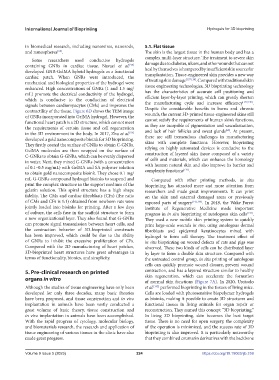Page 232 - IJB-9-5
P. 232
International Journal of Bioprinting Hydrogels for 3D bioprinting
in biomedical research, including nanowires, nanorods, 5.1. Flat tissue
and nanospheres . The skin is the largest tissue in the human body and has a
[95]
Some researchers used conductive hydrogels complex multi-layer structure. The treatment to severe skin
containing GNRs in cardiac tissue. Navaei et al. damage due to diabetes, ulcers, and other wounds that cannot
[95]
developed GNR-GelMA hybrid hydrogels as a functional heal by themselves is hampered by insufficient skin source for
cardiac patch. When GNRs were introduced, the transplantation. Tissue-engineered skin provides a new way
[137,138]
mechanical and biological properties of the hydrogel were of treating skin damage . Compared with traditional skin
enhanced. High concentrations of GNRs (1 and 1.5 mg/ tissue engineering technologies, 3D bioprinting technology
mL) promote the electrical conductivity of the hydrogel, has the characteristics of accurate cell positioning and
which is conducive to the conduction of electrical efficient layer-by-layer printing, which can greatly shorten
[139,140]
signals between cardiomyocytes (CMs) and improves the the manufacturing cycle and increase efficiency .
contractility of the tissue. Figure 6D shows the TEM image Despite the considerable benefits in burns and chronic
of GNRs incorporated into GelMA hydrogel. However, the wounds, the current 3D-printed tissue-engineered skins still
functional heart patch is a 2D structure, which cannot meet cannot satisfy the requirements of human skin’s functions,
the requirements of certain tissue and cell regeneration as they are incapable of pigmentation and vascularization,
[60]
in the 3D environment in the body. In 2017, Zhu et al. and lack of hair follicles and sweat glands . At present,
[94]
developed a gold nanocomposite bioink for 3D bioprinting. there are still tremendous challenges in manufacturing
They firstly coated the surface of GNRs to obtain C-GNRs. skins with complete functions. However, bioprinting
GelMA molecules are then wrapped on the surface of relying on highly automated devices is conducive to the
C-GNRs to obtain G-GNRs, which can be evenly dispersed construction of layered skin tissue composed of a variety
in water. Next, they mixed G-GNRs (with a concentration of cells and materials, which can enhance the homology
of 0.1–0.5 mg/mL) with GelMA and SA polymer solution with human natural skin and also improve its barrier and
[141]
to obtain gold nanocomposite bioink. They chose 0.1 mg/ complexity functions .
mL G-GNRs compound hydrogel bioinks to suspend and Compared with other printing methods, in situ
print the complex structure in the support medium of the bioprinting has attracted more and more attention from
gelatin solution. This spiral structure has a high shape researchers and made great improvements. It can print
fidelity. The CMs and cardiac fibroblasts (CFs) (the ratio on the skin and external damaged areas or previously
of CMs and CFs is 1:1) obtained from newborn rats were exposed parts of surgery [142,143] . In 2018, the Wake Forest
jointly loaded into bioinks for printing. After a few days Institute of Regenerative Medicine made important
of culture, the cells fuse in the scaffold structure to form progress in in situ bioprinting of autologous skin cells [144] .
a new organizational layer. They also found that G-GNRs They used a new mobile skin printing system to quickly
can promote signal transmission between heart cells, and print large-scale wounds in situ, using autologous dermal
the contraction behavior of 3D-bioprinted constructs fibroblasts and epidermal keratinocytes mixed with
has been improved, which could be due to the ability hydrogel to form cell therapy. The treatment effect of
of GNRs to inhibit the excessive proliferation of CFs. in situ bioprinting on wound defects of rats and pigs was
Compared with the 2D manufacturing of heart patches, observed. These two kinds of cells can be distributed layer
3D-bioprinted heart structures have great advantages in by layer to form a double skin structure. Compared with
terms of functionality, bionics, and simplicity. the untreated control group, in situ printing of autologous
cells can quickly promote wound closure, prevent wound
5. Pre-clinical research on printed contraction, and has a layered structure similar to healthy
organs in vitro skin regeneration, which can accelerate the formation
of normal skin functions (Figure 7A). In 2020, Urciuolo
Although the studies of tissue engineering have only been et al. [143] performed bioprinting in the tissues of living mice.
developed for only three decades, many basic theories Cells are loaded with photosensitive biopolymer hydrogels
have been proposed, and tissue construction and in vivo as bioinks, making it possible to create 3D structures and
implantation in animals have been vastly conducted a functional tissues in living animals for organ repair or
great volume of basic theory, tissue construction and reconstruction. They named this concept “3D bioprinting.”
in vivo implantation in animals have been accomplished. In living 3D bioprinting, skin becomes the best target
With the rapid progress of cytology, molecular biology, tissue. There is no need for open surgery, the complexity
and biomaterials research, the research and application of of the operation is minimized, and the success rate of 3D
tissue engineering of various tissues in the clinic have also bioprinting is also improved. It is particularly noteworthy
made great progress. that they combined coumarin derivatives with the backbone
Volume 9 Issue 5 (2023) 224 https://doi.org/10.18063/ijb.759

